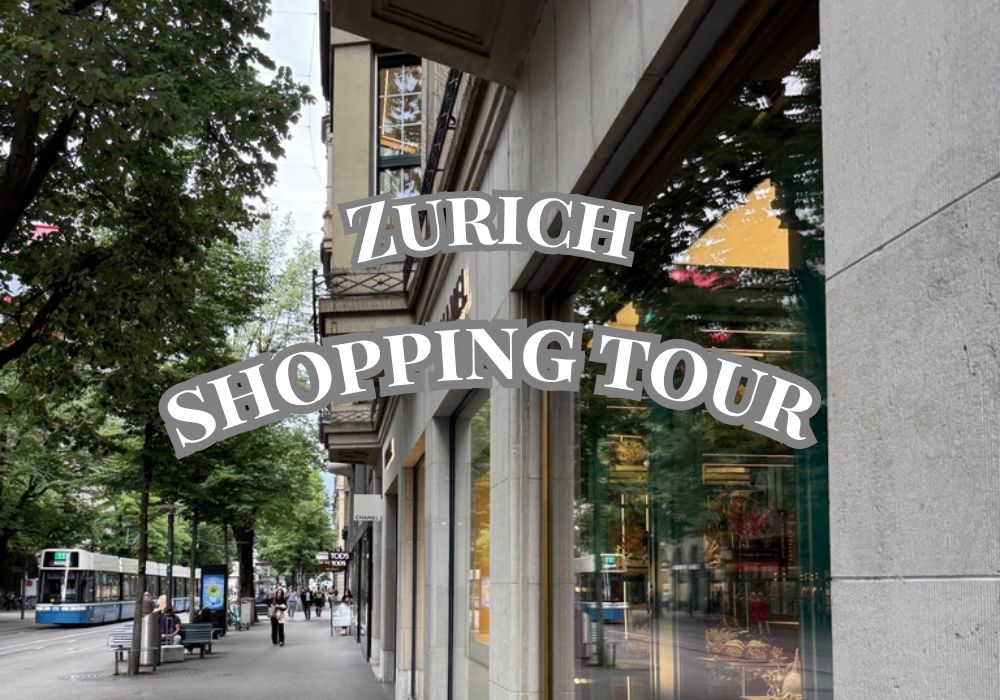
Zurich’s Bahnhofstrasse is a monument to fashion. Stretching from the lake to the main train station, it’s lined with polished window displays from global giants, luxury houses, and high-street staples. But beneath the clean branding and sleek interiors lies a question more and more shoppers are starting to ask: Are any of these clothes truly sustainable?
To answer that, we walked the length of Bahnhofstrasse with a sharper lens—not just looking at aesthetics or price tags, but at what the labels actually mean for people and the planet. What we found is revealing—and, in many cases, disappointing.
How We Rated the Brands
Each fashion label was evaluated on a 1–10 scale using five criteria:
- Use of certified materials (e.g. GOTS, OEKO-TEX, Fair Trade, GRS-certified recycled fibers)
- Transparency (traceability of materials and production processes)
- Business model (seasonless design, production volume, consumption pace)
- Circularity efforts (repairs, resale, recycling, take-back schemes)
- Social and environmental impact (climate commitments, labor rights, biodiversity goals)
Collectif mon Amour – 9/10
Nestled right on Bahnhofstrasse, Collectif mon Amour might be the street’s best-kept sustainable secret. Created by Swiss retail giant Coop, this label proves that ethical fashion doesn’t have to sacrifice elegance or accessibility. Every piece is thoughtfully designed, featuring soft neutral tones, clean silhouettes, and durable cuts meant to be worn—not just this season, but for many to come.
What sets Collectif mon Amour apart is its holistic commitment to sustainability. Materials include GOTS-certified organic cotton, TENCEL™, and recycled fibers, and each garment comes with full traceability. You know where your fabric was grown, woven, and sewn. Production happens mostly in Europe, under strict social standards that are clearly communicated to customers. In-store, the experience is calm and curated—no fast fashion chaos, no overwhelming racks.
Unlike many Bahnhofstrasse neighbors who speak sustainability but operate at high volume, Collectif mon Amour walks the talk at every level. It doesn’t just sell clothes—it redefines the relationship between consumer, garment, and planet.
Arket – 8/10
Arket, a Nordic lifestyle brand under the H&M Group, positions itself at the crossroads of minimalism and accountability. On each garment label, you’ll often find details about the country of production, the mill used, and the fabric’s properties. They utilize OEKO-TEX-certified materials and blend recycled synthetics with organic cotton. Their store design and merchandising reinforce a slower fashion mindset—neutral tones, core basics, and fewer seasonal collections. While still part of a fast-fashion empire, Arket feels more like a testing lab for what sustainable fashion could look like at scale.
COS – 7/10
COS, another H&M sibling, champions longevity through design. Their structured silhouettes and seasonless pieces are less trend-driven and more architecture-inspired. They use GOTS-certified cotton, TENCEL™ lyocell, and recycled fabrics, though certification is not universal. COS has made progress in supply chain mapping and has joined programs like the Ellen MacArthur Foundation’s Make Fashion Circular. However, COS’s full range isn’t audited independently, and their parent company still contributes to global overproduction.
Gucci – 7/10
Gucci sets the bar for sustainability within luxury. Through its Equilibrium platform, it reports on biodiversity goals, human rights audits, and supply chain traceability. GOTS-certified organic silk, leather alternatives, and responsible wool appear in select collections. The Environmental Profit & Loss accounting method, developed by parent company Kering, adds credibility. But Gucci’s exclusivity model and ongoing reliance on animal-derived materials complicate its sustainability story.
Prada – 6/10
Prada’s Re-Nylon line—made from regenerated ocean plastics and industrial waste—has received wide acclaim. They report certified cotton usage (GOTS, OCS, BCI) and claim to reach 70% certification by 2026. Yet Prada remains elusive on garment traceability, and its focus on innovation isn’t matched by a shift in its business model. Sustainability seems siloed, rather than systemic.
Hermès – 6/10
Hermès earns quiet respect for its investment in craft. Its products are made to last decades, and this inherent durability reduces waste. Its textile arm Bucol recently achieved GOTS certification, and the company supports artisan employment through vertical integration. However, its communication around sustainability is minimal, and product-level traceability is nonexistent.
Maje – 6/10
Initially presumed unsustainable, Maje has made a notable leap in transparency. Every item includes a QR code powered by Fairly Made®. Scanning it reveals precise material composition—including fibers like Birla Viscose™ and recycled polyamide—and identifies the exact location for each production stage, from knitting to dyeing. All the processes in the scanned example occurred in China, and while certifications are absent, this level of traceability is rare in the premium segment. Maje still runs seasonal collections and offers limited info on emissions or labor standards, but their tech-forward traceability earns points.
Globus – 6/10
Switzerland’s premium department store Globus curates a range of fashion—from local artisanal labels to international powerhouses. Amid this mix, you can find truly ethical brands like Veja or People Tree. The problem is: you have to dig. Globus does little to elevate or clearly label these products. It has yet to embrace sustainability as a core retail strategy. There are no in-store signs guiding you to eco-certified garments or platforms highlighting climate-responsible choices. It’s a missed opportunity.
Bongénie – 5/10
Bongénie (formerly Grieder) offers a slice of European luxury with an old-world boutique feel. Recently, it introduced vintage sections—an encouraging step that acknowledges fashion’s waste crisis. However, most of its inventory comes from labels that provide limited transparency. While the resale addition helps reduce the environmental footprint, Bongénie does not disclose supplier data or sustainability standards across its regular lines. Its contribution remains surface-level.
Loro Piana – 5/10
Loro Piana is known for its exquisite cashmere and wool, often sourced from remote regions and rare breeds. The brand has long emphasized quality and heritage, which inherently encourages garment longevity. It has made strides in raw material sourcing, such as controlling the supply chain for baby cashmere and vicuña. These fibers are naturally renewable and biodegradable, and Loro Piana supports community-based herding practices in Mongolia and Peru.
However, despite this responsible sourcing, the brand lacks public-facing sustainability metrics or certifications. There’s little transparency on chemical treatments, labor conditions, or environmental targets. Moreover, while its garments are built to last, there is no evidence of circularity programs like take-back, repair, or resale. As a heritage luxury brand, Loro Piana’s values align partially with sustainability—but fall short of a comprehensive strategy.
Mango – 3/10
Mango has publicly committed to using “sustainable cotton” by 2025, including BCI, recycled, and organic options. While they participate in industry initiatives like the Fashion Pact, they rarely publish product-specific certification info. Most Mango items lack QR-coded traceability or verified standards. The brand still releases new items weekly, encouraging high-frequency consumption. Efforts like Committed collections exist, but without structural change, these feel more cosmetic than corrective.
Massimo Dutti – 3/10
As a more refined member of the Inditex family, Massimo Dutti markets quiet luxury. It features the Join Life label, which suggests better fibers and reduced-impact processes. But like Mango, its transparency ends there. It offers no evidence of labor audits, environmental reporting, or product lifecycle tracking. The pieces may look elegant, but their origin stories are vague. It’s green gloss over a traditional fast-fashion engine.
Zara – 2/10
Zara is everywhere—and for many, it’s the gateway to fast fashion. Its draw lies in its speed: new styles arrive in-store every week, and seasonal trends become microtrends within days. But that speed comes at a cost. While Zara promotes its “Join Life” label and sets goals for using more sustainable materials by 2025, most of these changes remain surface-level. Products rarely come with third-party certifications or verifiable sourcing details. Claims about organic cotton or recycled polyester are often vague, and the brand offers little item-level transparency.
The real problem? Zara’s business model depends on disposability. High volumes, rapid production, and built-in obsolescence directly contradict sustainability at its core. Ambitious climate pledges mean little when the shelves are constantly being restocked with more. Even with better materials, the system remains extractive. Until Zara slows down—and shows its math—its green messaging rings hollow.
Chanel – 2/10
Chanel speaks often of innovation but remains vague about how it protects people and the planet. Its focus is on legacy, not transparency. No public certifications, no disclosed labor policies, no known circularity programs. Even with high product quality, its opacity is no longer acceptable.
Dolce & Gabbana – 2/10
Dolce & Gabbana frequently celebrates Italian artisanship, but offers no proof of sustainable practices. Its materials are mostly conventional, and its website features no data or third-party verification. In an age of climate urgency, silence is a statement.
Tally Weijl – 2/10
Tally Weijl, a Swiss-born brand known for ultra-trendy, affordable fashion, operates at the fast end of fast fashion. While the company has recently launched small capsule collections made from organic or recycled materials, these are the exception, not the rule. The overwhelming majority of garments are made for trend turnover, often with synthetic fabrics like polyester that lack traceability or certification.
The brand does not disclose detailed supply chain data, does not offer repair or recycling programs, and rarely communicates any long-term sustainability strategy. The pace of production is high, and garments are priced to be disposable. While Tally Weijl speaks the language of empowerment, its model remains deeply unsustainable.
So, Is Bahnhofstrasse Sustainable?
Mostly, no. While a few brands like Arket, COS, and Gucci are pushing forward, most of Bahnhofstrasse still promotes consumption-first fashion with minimal accountability. The system isn’t built for sustainability. It’s built for speed, novelty, and margins.
Real sustainability means rethinking how we design, price, and sell clothing—from the farm to your closet. It means fewer, better things, certified and traceable. It’s possible. But it’s not yet standard on Bahnhofstrasse.
If you want to shop better, consider moving a few tram stops away. Zurich is home to truly committed stores like Zämä, Changemaker, and RRREVOLVE. These retailers curate for sustainability, not seasonality.
Until Bahnhofstrasse evolves, it remains a place of beautiful illusions. Stylish? Absolutely. Sustainable? Only in fragments. And as conscious shoppers, that distinction matters more than ever.
Have a look at my TikToks:
Maje Review TikTok
Reviewing Brands TikTok
Shops at Zurich Bahnhofstrasse TikTok
Catch up on previous posts:
Sustainable and Cute? These Fashion Brands Actually Deliver
3 Innovative Materials That Could Actually Change Fashion
How to Spot Greenwashing in Fashion
Polyester: Why Fashion’s Favorite Fabric Comes at a Cost
Cotton Confusion: How to Read the Labels Like a Pro
Not All Plant-Based Fabrics Are Sustainable—Here’s Why
What Are Your Clothes Really Made Of?
And if this gave you clarity, follow me on Instagram @labeldecoder for weekly facts, fabric deep-dives, and shopping tips.




